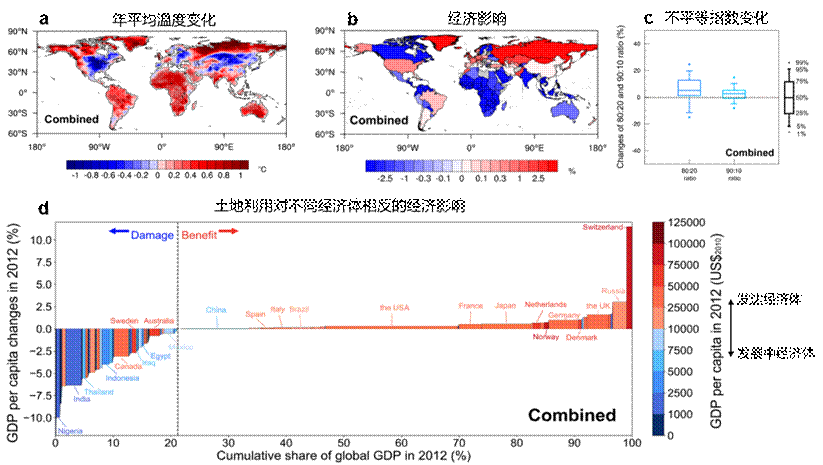Associate Professor Wang Yong’s Research Group of the Department of Earth System Science (DESS), Tsinghua, by multi-model climate simulation experiments and temperature-economy assessment model from the Coupled Model Intercomparison Project Phase 6 (CMIP6), estimated the biogeophysical (BGP) and biogeochemical (BGC) impacts on mean surface air temperature (SAT) and day-to-day SAT variability are estimated and then further analyzed their impacts on the global economy.
Climate change has significant implications for macro-economic growth by influencing agricultural yields, energy supply, labor productivity, and human health. Earlier observational research has proven that the per capita gross domestic product (GDP) growth rate of a country peaked at optimal temperature and declined at higher or lower temperatures. The impacts of greenhouse gases and anthropogenic aerosols on economies via altered annual mean temperature (AMT) have been studied. Anthropogenic land-use and land-cover change (LULCC) as a result of humans’ growing demands for food, fiber, and shelter, with extensive natural landscapes being converted to human-dominated lands, such as cropland, grazing land, and urban impervious surface is also an important way for human activities to impact climate change besides greenhouse gases and anthropogenic aerosols. Land use can produce both biogeophysical (BGP) impacts (changing surface albedo, Bowen ratio, etc.) and biogeochemical impacts (causing greenhouse gas emissions, etc.), and its biogeophysical impacts vary with the disturbed surface types and latitudes. Therefore, the impacts of historical land use on global temperature and economy is still unclear.
With a view to the above problems, the Research Team designed the research route of historical land use-temperature response-economic impact. Through CMIP6 climate simulation experiments, it has been found that the biogeophysical impacts of historical land use cause the temperature in most parts of the world to drop (especially in the middle and high latitudes of the Northern Hemisphere), while the biogeochemical impacts cause the global temperature to rise. In most parts of the world, the biogeochemical impacts of land use are dominant in the comprehensive effect of the two, causing the annual average temperature in these areas to rise (Fig. 1a). Therefore, the economic development of developing countries with hot climate will be negatively affected by it, while it is beneficial to the economic development of developed countries with cold climate. Such different economic impacts aggravate global economic inequality (Fig. 1). In addition, the study has found that the comprehensive effect of land use increased the frequency of extreme temperature events in developing countries, but decreased the frequency of extreme temperature events in developed countries, which further deteriorates global economic inequality aggravated the global economic inequality (Fig. 2).
The economic impacts caused by the climate impacts of historical land use have been evaluated, which is of important guiding significance for the rational planning of future land use and the formulation of climate change mitigation policies.

Fig. 1: The biogeophysical (BGP) and biogeochemical (BGC) impacts of historical land-use on economies via annual-mean surface air temperature (SAT) changes.

Fig. 2: Cumulative economic impacts via annual-mean day-to-day surface air temperature (SAT) variability changes due to biogeophysical (BGP) and biogeochemical (BGC) impacts of historical land-use
The above results have been published on line in a paper titled “Contrasting Influences of Biogeophysical and Biogeochemical Impacts of Historical Land Use on Global Economic Inequality in Nature Communications on May 5, 2022.
Liu Shu, a Class 2019 doctoral candidate of the DESS, Tsinghua University is the first author of the paper and Associate Professor Wang Yong of the DESS, Tsinghua University is the corresponding author. Wei Linyi, a doctoral candidate of the DESS, Tsinghua University, Wang Bin, Distinguished Associate Professor of the DESS, Tsinghua University and Researcher of the Institute of Atmospheric Physics, Chinese Academy of Sciences, and Associate Professor Yu Le of the DESS, Tsinghua University are the co-authors of the paper. This research is supported by the Key Research and Development Program of the Ministry of Science and Technology and the National Natural Science Foundation of China.
Full text link of the paper:
https://www.nature.com/articles/s41467-022-30145-6
Contributed by Liu Shu and Wang Yong
Edited by Wang Jiayin
Reviewed by Zhang Qiang